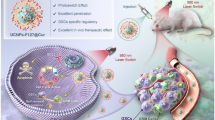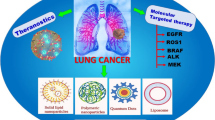Abstract
Background
In radiotherapy, therapeutic efficacy for the control of cancer is often limited by tumor tissue radioresistance including nasopharyngeal carcinoma. Exposure of cells to ionizing radiation (IR) leads to the formation of reactive oxygen species that are associated with radiation-induced cellular apoptosis and necrosis. The antioxidant enzyme manganese superoxide dismutase (SOD2) catalyzes the dismutation of the superoxide anions into hydrogen peroxide.
Methods
We have investigated the potential of SOD2 gene silencing, through plasmid transfer using a microRNA interference optimized for transcription in nasopharyngeal carcinoma cell line cells, to degrade the radioresistance of a human nasopharyngeal carcinoma cell line. Using these as in vitro models we have investigated whether SOD2 gene therapy may be suitable for the reduction of the nasopharyngeal carcinoma resistance to the effects of IR.
Results
Here we demonstrate using both biological and physical assays that silencing of SOD2 enhances the radiosensitivity of nasopharyngeal carcinoma cells to IR injury. Our results show that a decrease in the levels of SOD2 mRNA and protein within CNE1 cells (down-regulated 65 and 80%) leads to a significant decrease in clonogenic survival (from 24.5 to 9.67% at 2 Gy, from 9.12 to 2.45% at 4 Gy), as evident by a significant decrease in Dbar (from 1.923 to 0.617 Gy), SF2 (from 0.403 to 0.021) values, and a significant increase in the α value (from 0.228 ± 0.070 to 1.064 ± 0.210/Gy) when compared either to cells transduced with a Gateway®-adapted expression vector encoding EmGFP alone or to the parental line.
Conclusions
The results presented suggest that miRNA for silencing SOD2 radiosensitizing gene therapy maybe applicable to the nasopharyngeal carcinoma, improving the therapeutic ratio of cancer radiotherapy.


Similar content being viewed by others
References
Ayene IS, Stamato TD, Mauldin SK et al (2002) Mutation in the glucose-6-phosphate dehydrogenase gene leads to inactivation of Ku DNA end binding during oxidative stress. J Biol Chem 277:9929–9935
Biaglow JE, Varnes ME, Clark EP et al (1983) The role thiols in cellular response to radiation and drugs. Radiat Res 95:437–455
Biaglow JE, Mitchell JB, Held K (1992) The importance of peroxide and superoxide in the X-ray response. Int J Radiat Oncol Biol Phys 22:665–669
Chance B, Sies H, Boveris A (1979) Hydroperoxide metabolism in mammalian organs. Physiol Rev 59:527–605
Cheeseman KH, Slater TF (1993) An introduction to free radicals biochemistry. Br Med Bull 49:481–493
Crapo JD, Oury T, Rabouille C et al (1992) Copper, zinc superoxide dismutase is primarily a cytosolic protein in human cells. Proc Natl Acad Sci USA 89:10405–10409
Epperly MW, Bray JA, Krager S, Berry LA, Gooding W, Engelhardt JF, Zwacka R, Travis E, Greenberger JS (1999) Intratracheal injection of adenovirus containing the human MnSOD transgene protects athymic nude mice from irradiation-induced organizing alveolitis. Int J Radiat Oncol Biol Phys 43:169–181
Epperly MW, Gretton JA, DeFilippi SJ, Greenberger JS, Sikora CA, Liggitt D, Koe G (2001) Modulation of radiation-induced cytokine elevation associated with esophagitis and esophageal stricture by manganese superoxide dismutase-plasmid/liposome (SOD2-PL) gene therapy. Radiat Res 155:2–14
Epperly MW, Gretton JE, Sikora CA et al (2003) Mitochondrial localization of superoxide dismutase is required for decreasing radiation-induced cellular damage. Radiat Res 160:568–578
Epperly MW, Osipov AN, Martin I et al (2004) Ascorbate as a “redox sensor” and protector against irradiation-induced oxidative stress in 32D CL 3 hematopoietic cells and subclones overexpressing human manganese superoxide dismutase. Int J Radiat Oncol Biol Phys 58:851–861
Freeman BA, Crapo JD (1982) Biology of disease: free radicals and tissue injury. Lab Invest 47:412–426
Guo GZ, Yan-Sander Y, Lyn-Cook BD et al (2003) Manganese superoxide dismutase-mediated gene expression in radiation-induced adaptive responses. Mol Cell Biol 23(70):2362–2378
Hall EJ (2000) Radiobiology for the radiologist. Lippincott Williams & Wilkins, Philadelphia
Jia L, Jiang XR, Razak K et al (1995) TNF-mediated killing of human leukaemic cells: effects of endogenous antioxidant levels and TNF alpha expression in leukaemic cell lines. Leuk Res 19:187–194
Kanai AJ, Zeidel ML, Lavelle JP, Greenberger JS, Birder LA, de Groat WC, Apodaca GL, Meyers SA, Ramage R, Epperly MW (2002) Manganese superoxide dismutase gene therapy protects against irradiation-induced cystitis. Am J Physiol Renal Physiol 283:F1304–F1312
Keller GA, Warner TG, Steimer KS et al (1991) Cu, Zn superoxide dismutase is a peroxisomal enzyme in human fibroblasts and hepatoma cells. Proc Natl Acad Sci USA 88:7381–7385
Kim SG, Nam SY, Kim CW et al (1997) Enhancement of radiation-inducible hepatic glutathione-S-transferases Ya, Yb1, Yb2, Yc1, and Yc2 gene expression by oltipraz: possible role in radioprotection. Mol Pharmacol 51(2):225–233
Marklund SL (1984) Extracellular superoxide dismutase in human tissues and human cell lines. J Clin Invest 74:1398–1403
Mitchell JB, Russo A (1987) The role of glutathione in radiation and drug induced cytotoxicity. Br J Cancer Suppl 8:S96–S104
Oberley LW, Lindgren AL, Baker SA et al (1976) Superoxide ion as the cause of the oxygen effect. Radiat Res 68:320–328
Oberley LW, St Clair DK, Autor AP et al (1987) Increase in manganese superoxide dismutase activity in the mouse heart after X-irradiation. Arch Biochem Biophys 254:69–80
Parkin MD, Muir CS, Whelan SL et al (1992) Cancer incidence in five continents, vol VI. IARC Science Publications No. 120. IARC, Lyon
Peskin AV, Winterbourn CC (2000) A microtiter plate assay for superoxide dismutase using a watersoluble tetrazolium salt (WST-1). Clin Chim Acta 293:157–166
Petkau A, Chelack WS, Pleskach SD (1976) Protection of post irradiated mice by superoxide dismutase. Int J Radiat Biol 29:297–299
Roberts SA (1990) DRFIT: a program for fitting radiation survival models. Int J Radiat Biol 57:1243–1246
Sambrook J, Fritsch EF, Maniatis T (1989) Molecular cloning: a laboratory manual, 2nd edn, vol 3. Cold Spring Harbour Laboratory Press, New York
Shimizu T, Iwanaga M, Yasunaga A et al (1998) Protective role of glutathione synthesis on radiation-induced DNA damage in rabbit brain. Cell Mol Neurobiol 18:299–310
Southgate TD, Sheard V, Milsom MD et al (2006) Radioprotective gene therapy through retroviral expression of manganese superoxide dismutase. J Gene Med 8:557–565
Summers RW, Maves BV, Reeves RD et al (1989) Irradiation increases superoxide dismutase in rat intestinal smooth muscle. Free Radic Biol Med 6:261–270
Tannock IF, Hill RP (1999) The basic science of oncology, 3rd edn. McGraw-Hill, Singapore, pp 219–237
Tuttle SW, Varnes ME, Mitchell JB et al (1992) Sensitivity to chemical oxidants and radiation in CHO cell lines deficient in oxidative pentose cycle activity. Int J Radiat Oncol Biol Phys 22:671–675
Williams MD, Van Remmen H, Conrad CC et al (1998) Increased oxidating damage is correlated to altered mitochondrial function in heterozygous manganese superoxide dismutase knockout mice. J Biol Chem 273:28510–28515
Wispe JR, Clark JC, Burhans MS et al (1989) Synthesis and processing of the precursor for human mangano-superoxide dismutase. Biochim Biophys Acta 994:30–36
Yamaguchi S, Sakurada S, Nagumo M (1994) Role of intracellular SOD in protecting human leukemic and cancer cells against superoxide and radiation. Free Radic Biol Med 17:389–395
Acknowledgments
We thank Dr Hua Zhang for insightful advice, Dr Xinzhang Cai and Mr Chenglong Wang for technical assistance.
Author information
Authors and Affiliations
Corresponding author
Rights and permissions
About this article
Cite this article
Qu, Y., Zhao, S., Hong, J. et al. Radiosensitive gene therapy through imRNA expression for silencing manganese superoxide dismutase. J Cancer Res Clin Oncol 136, 953–959 (2010). https://doi.org/10.1007/s00432-009-0739-5
Received:
Accepted:
Published:
Issue Date:
DOI: https://doi.org/10.1007/s00432-009-0739-5




